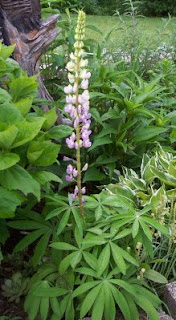
The picture below shows some that were transplanted earlier this spring. I like primroses best when they are mixed with other flowers like the picture above.

 This one is being crowded, so once the flowers surrounding it are done blooming for the summer, some of the plants will need to be moved around.
This one is being crowded, so once the flowers surrounding it are done blooming for the summer, some of the plants will need to be moved around. This particular variety grows from 25" to 30" tall and prefers full sun to partial shade. Cutting the faded flowers at the base of the plant will help keep them strong and healthy.
This particular variety grows from 25" to 30" tall and prefers full sun to partial shade. Cutting the faded flowers at the base of the plant will help keep them strong and healthy. Fast growing, they prefer full sun to partial shade. Give them lots of space to grow! Some varieties grow as tall as 30 feet and can be trained to climb a trellis. This one is overgrowing the butterfly garden. It's already been cut back once this spring.
Fast growing, they prefer full sun to partial shade. Give them lots of space to grow! Some varieties grow as tall as 30 feet and can be trained to climb a trellis. This one is overgrowing the butterfly garden. It's already been cut back once this spring. They prefer full sun to partial shade. Depending of the variety, the dainty flowers can grow from 15" to 36" tall. The leaves at the base of the plant grow to a height of 12" - 24" tall.
They prefer full sun to partial shade. Depending of the variety, the dainty flowers can grow from 15" to 36" tall. The leaves at the base of the plant grow to a height of 12" - 24" tall.




 Caution: Ants are attracted to the nectar in the flowers. Remove any of these critters before bringing inside.
Caution: Ants are attracted to the nectar in the flowers. Remove any of these critters before bringing inside.



 After the rhubarb is pulled, I cut off the poisonous leaves and leave them laying in the garden to compost. Plants should be spaced about 36" apart. As you can see, these plants are too close together and will need to be split up after the growing season.
After the rhubarb is pulled, I cut off the poisonous leaves and leave them laying in the garden to compost. Plants should be spaced about 36" apart. As you can see, these plants are too close together and will need to be split up after the growing season. It's time to head for the kitchen and make the Rhubarb Crisp!
It's time to head for the kitchen and make the Rhubarb Crisp!
Oven Temperature:
Preheat Oven to 350 degrees.
Arrange shelves to place the baking pan on the middle shelf of your oven.
Crust/Topping:
1 cup Butter
Place Butter in a large bowl to soften while cooking the Filling.
Save the Butter Wrappers on a plate.
Filling:
Preparing the Rhubarb:
Remove and discard leaves, ends, bad spots and any “stringy stuff” from the stalk. Dice stalk into 1/4" pieces. *If rhubarb has not been frozen or is not freshly picked, allow to stand in a jar of cold water for about an hour before using. Rinse well before dicing.
3 cups diced Rhubarb
4 TBSP Cornstarch
1 cup Sugar
1/4 cup water
Place Rhubarb in a pan on the stove.
Mix Cornstarch and Sugar together and pour over the rhubarb.
Add water.
Mix ingredients together and cook on low until thick, stirring occasionally with a heat resistant spatula to keep ingredients from sticking to the bottom of the pan. Remove from heat.
Add 1 tsp. vanilla, stir and set aside to cool.
Crust/Topping:
1 1/2 cups Flour
1 1/2 cups Oatmeal
1 cup Brown Sugar
1/4 tsp Baking Soda
Add the ingredients for the Crust/Filling to the Butter and mix using a pastry blender until mixture is crumbly.
Take 1 1/2 cups of the mixture and set aside for the Topping.
Pour remaining Crust ingredients into a 9”X13” ungreased Baking Pan and pat down using the Butter Wrappers and spatula.
Pour the cooled Filling over the top of the crust.
Sprinkle the Topping mixture evenly over the top of the filling.
Bake for 35 minutes.
Cool before cutting.